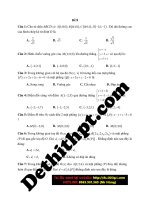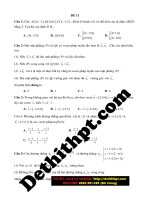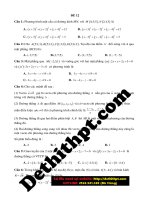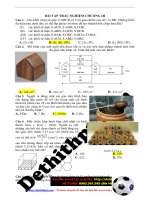Đề 47 image marked image marked
Bạn đang xem bản rút gọn của tài liệu. Xem và tải ngay bản đầy đủ của tài liệu tại đây (1.33 MB, 6 trang )
Exercise 47:
Read the following passage and mark the letter A, B, C or D to indicate the correct answer to each
of the questions.
The modem comic strips started out as ammunition in a newspaper war between giants of the
American press in the late nineteenth century.
The fist full-color comic strip appeared in January 1894 in the New York World, owned by Joseph
Pulitzer. The fist regular weekly full¬color comic supplement, similar to today's Sunday funnies,
appeared two years later, in William Randolph Hearst's rival New York paper, the Morning Journal.
Both were immensely popular and publishers realized that supplementing the news with comic relief
boosted the sale of papers. The Morning Journal started another feature in 1896, the "Yellow Kid", the
first continuous comic character in the United States, whose creator, Richard Outcault, had been lured
away from the World by the ambitious Hearst. The "Yellow Kid" was in many ways a pioneer. Its comic
dialogue was the strictly urban farce that came to characterize later strips, and it introduced the speech
balloon inside the strip, usually placed above the characters' heads.
The first strip to incorporate all the elements of later comics was Rudolph Dirks's "Katzenjammer
Kids", based on Wilhelm Busch's Max and Moritz, a European
satire of the nineteenth century. The "Kids" strip, fist published in
1897, served as the prototype for future American strips. It
contained not only speech balloons, but a continuous cast of
characters, and was divided into small regular panels that did away
with the larger panoramic scenes of earlier comics. Newspaper
syndication played a major role in spreading the popularity of
comic strips throughout the country. Though weekly colored
comics came first, daily black-and- white strips were not far
behind. The first appeared in the Chicago American in 1904. It was
followed by many imitators, and by 1915 black-and-white comic
strips had become a staple of daily newspapers around the country.
QUESTION
Question 1: In what order does the author discuss various comic strips in the passage?
A. In the order in which they were created.
B. From most popular to least popular.
C. According to the newspaper in which they appeared.
D. In alphabetical order by title.
Đăng ký file Word tại link sau
/>
Question 2: According to the passage, the "Yellow Kid" was the first comic strip to do all of the
following EXCEPT_____.
Trang 1
A. feature the same character in each episode B. include dialogue inside a balloon
C. appear in a Chicago newspaper
D. characterize city life in a humorous way
Question 3: The word "prototype" in paragraph 3 is closest in meaning to ______.
A. model
B. story
C. humor
D. drawing
Question 4: The word "staple" at the end of paragraph 3 is closest inmeaning to _________.
A. new version
B. huge success C.regular feature
D.
popular edition
Question 5: The word "incorporate" is closest in meaning to______.
A. combine
B. mention
C. create
D. affect
Question 6: Why does the author mention Joseph Pulitzer and William Randolph Hearst?
A. Their comic strips are still published today.
B. They owned major competitive newspapers.
C. They established New York's first newspaper.
D. They published comic strips about the newspaper war.
Question 7: The word "it" at the end of paragraph 2 refers to ______.
A. balloon
B. farce
C. dialogue
D. the "Yellow Kid"
Question 8: The passage suggests that comic strips were popular for which of the following reasons?
A. Readers enjoyed the unusual drawings.
B. They were about real-life situations.
C. Readers could identify with the characters.
D. They provided a break from serious news stories.
Question 9: To say that Richard Outcault had been "lured away from" the World by Hearst means
which of the following?
A. Hearst warned Outcault not to leave the World.
B. Hearst convinced Outcault to leave the World.
C. Hearst fired Outcault from the World.
D. Hearst wanted Outcault to work for the World.
Question 10: What does the passage mainly discuss?
A. The differences between early and modern comic strips.
B. Features of early comic strips in the United States.
C. The effects of newspapers on comic strip stories.
D. A comparison of two popular comic strips.
Trang 2
GIẢI CHI TIẾT
Question 1: In what order does the author discuss various comic strips in the passage?
A. In the order in which they were created.
B. From most popular to least popular.
C. According to the newspaper in which they appeared.
D. In alphabetical order by title.
Dịch nghĩa: Theo trình tự nào tác giả thảo luận về những mẩu truyện tranh khác nhau?
A. Theo trình tự chúng được tạo ra B. Từ cái phổ biến nhất đến ít phổ biến nhất
C. Theo tờ báo mà chúng xuất hiện
D. Theo trình tự bảng chữ cái theo tiêu đề
Giải thích: Ta thấy khi thảo luận về những loại truyện tranh khác nhau, tác giả đã miêu tả theo trình tự
thời gian:
1894: fist full color comic - truyện tranh màu đầu tiên
Two years later: Regular weekly full color comic supplement - sự cung cấp truyện tranh màu đầu tiên
1896: Yellow Kid
1897:"Katzenjammer Kids"
Question 2: According to the passage, the "Yellow Kid" was the first comic strip to do all of the
following EXCEPT_____.
A. feature the same character in each episode B. include dialogue inside a balloon
C. appear in a Chicago newspaper
D. characterize city life in a humorous way
Dịch nghĩa: Theo bài viết, "Yellow Kid" là mẩu truyện tranh đầu tiên làm tất cả những điều sau NGOẠI
TRỪ ___________________.
A. khắc họa cùng 1 nhân vật ở mỗi tập
B. đặt hội thoại trong những hình bong bóng
C. xuất hiện ở báo Chicago
D. khắc họa cuộc sống ở thành phố một cách hài hước
Giải thích: Ta thấy các đáp án còn lại đều được đề cập về "Yellow Kid""the "Yellow Kid", the first
continuous comic character in the United States... Its comic dialogue was the strictly urban farce that
came to characterize later strips, and it introduced the speech balloon inside the strip"-""Yellow Kid",
nhân vật truyện tranh liên tục đầu tiên ở Mỹ... Những mẩu hội thoại truyện tranh của nó là những vở hài
kịch đô thị mà đã định hình những truyện tranh tiếp theo, và nó đã đưa vào những bong bóng hội thoại
trong mẩu chuyện..."
Question 3: The word "prototype" in paragraph 3 is closest in meaning to ______.
A. model
B. story
C. humor
D. drawing
Dịch nghĩa: Từ "prototype" ở đoạn 3 gần nghĩa nhất với _________.
A. hình mẫu
B. câu chuyện
C. tính hài hước
D. phiên bản thông dụng
Giải thích: Ta có: prototype = model: hình mẫu
Question 4: The word "staple" at the end of paragraph 3 is closest inmeaning to _________.
Trang 3
A. new version
B. huge success C .regular feature
D.
popular edition
Dịch nghĩa: Từ "staple" ở cuối đoạn 3 gân nghĩa nhất với ________.
A. phiên bản mới
B. thành công lớn
C. hình tượng phổ biến
D. phiên bản phổ biến
Giải thích: Ta có: staple = regular feature: hình tượng, điều phổ biến trong cuộc sống
Question 5: The word "incorporate" is closest in meaning to______.
A. combine
B. mention
C. create
D. affect
Dịch nghĩa: Từ "incorporate"gần nghĩa nhất với________________
A. kết hợp
B. đề cập đến
C. tạo ra
D. ảnh hưởng
Giải thích: Ta có trong văn cảnh này (to) incorporate = (to) combine: kết hợp
Question 6: Why does the author mention Joseph Pulitzer and William Randolph Hearst?
A. Their comic strips are still published today.
B. They owned major competitive newspapers.
C. They established New York's first newspaper.
D. They published comic strips about the newspaper war.
Dịch nghĩa: Tại sao tác giả đề cập đến Joseph Pulitzer và William Randolph Hearst?
A. Những mẩu truyện tranh của họ vẫn được xuất bản ngày nay.
B. Họ sở hữu những tờ báo cạnh tranh lớn.
C. Họ thành lập nên tờ báo New York đầu tiên.
D. Họ xuất bản những mẩu truyện tranh về chiến tranh trong
ngành báo chí.
Giải thích: Đọc dòng đầu tiên đoạn 2 khi tác giả nói về 2 tờ báo
New York World và Morning Journal: "Both were immensely
popular..."-"Cả 2 đều cực kì phổ biến..." "The modern comic strip
started out as ammunition in a newspaper war between giants of the
American press in the late nineteenth century. The fist full-color
comic strip appeared in January 1894 in the New York World,
owned by Joseph Pulitzer. The fist regular weekly full-color comic
supplement, similar to today's Sunday funnies, appeared two
yearslater, in William Randolph Hearst's rival New York paper, the Morning Journal."
Như vậy có thể suy ra rằng 2 tờ báo sở hữu bởi Joseph Pulitzer và William Randolph Hearst
là những tờ báo lớn mang tính cạnh tranh cao
Question 7: The word "it" at the end of paragraph 2 refers to _____.
A. balloon
B. farce
C. dialogue
D. the "Yellow Kid"
Dịch nghĩa: Từ "it" ở cuối đoạn 2 để cập đến ________.
A. bong bóng
B. hài kịch
C. hội thoại
D. Yellow Kid
Giải thích: Ta thấy: "The "Yellow Kid" was in many ways a pioneer. Its comic dialogue was the strictly
urban farce that came to characterize later strips, and it introduced..."- "Yellow Kid" đã là một nhà tiên
Trang 4
phong. Những mẩu hội thoại truyện tranh của nó là những vở hài kịch mà đã định hình những truyện
tranh tiếp theo, và nó đã đưa vào..."
Question 8: The passage suggests that comic strips were popular for which of the following reasons?
A. Readers enjoyed the unusual drawings.
B. They were about real-life situations.
C. Readers could identify with the characters.
D. They provided a break from serious news stories.
Dịch nghĩa: Bài viết nêu ra rằng những mẩu truyện tranh vẫn phổ biến với lí do nào sau đây?
A. Độc giả yêu thích những bức vẽ bất thường.
B. Chúng nói về những tình huống thực tế.
C. Độc giả có thể phân biệt những tác giả.
D. Chúng cung cấp một quãng nghỉ khỏi những câu chuyện tin tức nghiêm túc.
Giải thích: Ta thấy:"...supplementing the news with comic relief boosted the sale of papers"- ".. .cung
cấp những tin tức với một sự xoa dịu dạng truyện tranh làm tăng doanh thu"
Như vậy có thể hiểu là truyện tranh phổ biến vì chúng cho ta một quãng nghỉ khỏi những tin tức
nghiêm trọng.
Question 9: To say that Richard Outcault had been "lured away from" the World by Hearst means
which of the following?
A. Hearst warned Outcault not to leave the World.
B. Hearst convinced Outcault to leave the World.
C. Hearst fired Outcault from the World.
D. Hearst wanted Outcault to work for the World.
Dịch nghĩa: Để nói rằng Richard Outcault đã bị "lured away from" tờ Thế Giới bởi Hearst nghĩa là ___.
A. Hearst cảnh báo Outcault không được rời tờ Thế Giới.
B. Hearst đã thuyết phục Outcault rời khỏi tờ Thế Giới.
C. Hearst đuổi việc Outcault khỏi tờ Thế Giới.
D. Hearst muốn Outcault làm việc cho tờ Thế Giới.
Giải thích: (to) lure smb into/out of/ away from sth: dụ dỗ ai đó vào, ra khỏi chuyện gì = (to) convince
smb to do sth
Question 10: What does the passage mainly discuss?
A. The differences between early and modern comic strips.
B. Features of early comic strips in the United States.
C. The effects of newspapers on comic strip stories.
D. A comparison of two popular comic strips.
Dịch nghĩa: Bài viết chủ yếu thảo luận vấn đề gì?
A. Sự khác biệt giữa những mẩu truyện tranh cũ và hiện đại
Trang 5
B. Những đặc điểm của những mẩu truyện tranh lúc mới xuất hiện ở Mỹ
C. Tác động của báo chí đối với những mẩu truyện tranh
D. Một sự so sánh giữa 2 mẩu truyện tranh nổi tiếng
Giải thích: Ta thấy ngay câu đầu tiên đã đề cập đến "The modern comic strips"-"Những mẩu truyện tranh
hiện đại"
DỊCH BÀI
Những mẩu truyện tranh hiện đại đã xuất hiện như một vũ
khí trong một cuộc chiến trong ngành báo chí giữa những nhà
xuất bản lớn Mỹ ở cuối thế kỉ 19.
Mẩu truyện tranh màu đầu tiên xuất hiện vào tháng 1 năm
1894 ở tờ Thế Giới New York, được sở hữu bởi Joseph Pulitzer.
Sự xuất bản hàng tuần của những mẩu truyện tranh màu, giống
với những mẩu truyện hài vào Chủ Nhật ngày nay, đã xuất hiện
2 năm sau đó, trong tờ báo đối thủ của tờ New York của William
Randolph Hearst, tờ Nhật báo Buổi sáng.
Cả 2 đều cực kì phổ biến và những nhà xuất bản đã nhận ra
rằng cung cấp những tin tức với một sự xoa dịu dạng truyện
tranh làm tăng doanh thu.
Tờ Nhật báo Buổi sang đã bắt đầu một dự án khác năm 1896, "Yellow Kid", nhân vật truyện tranh
liên tục đầu tiên ở Mỹ, mà tác giả của nó, Richard Outcault, đã bị dụ ra khỏi tờ Thế Giới bởi ngài Hearst
tham lam. "Yellow Kid" đã là một nhà tiên phong theo nhiều cách. Những mẩu hội thoại truyện tranh của
nó là những vở hài kịch mà đã định hình những truyện tranh tiếp theo, và nó đã đưa vào những bong bóng
hội thoại trong mẩu chuyện, thường được đặt phía trên đầu của nhân vật.
Mẩu truyện đầu tiên kết hợp tất cả những yếu tố của truyện tranh thế hệ sau là "Katzenjammer Kids"
của Rudolph Dirk, dựa trên truyện "Max và Moritz" của Wilhelm Busch, một truyện châm biếm châu Âu
của thế kỉ 19.
Những mẩu truyện "Kids", được xuất bản lần đầu năm 1897, đã có tác dụng như hình mẫu cho truyện
tranh Mỹ trong tương lai. Nó bao gổm không chỉ những bong bóng hội thoại, mà còn một loạt nhân vật
lặp đi lặp lại, và đã được phân chia thành những bảng khác nhau, bỏ đi những cảnh lớn như trong truyện
tranh thời kì trước.
Sự hợp tác báo chí đã đóng một vai trò lớn trong việc quảng bá tên tuổi của truyện tranh khắp đất
nước. Mặc dù những truyện tranh màu hàng tuần xuất hiện trước, truyện tranh đen trắng hàng ngày đã
xuất hiện ngay sau đó. Cái đầu tiên đã xuất hiện ở tờ Chicago nước Mỹ năm 1904. Nó đâ được kế tục bởi
rất nhiều người bắt chước, và đến năm 1915 truyện tranh đen trắng đã trở thành một điều quen thuộc
trong nhật báo khắp cả nước.
Trang 6









